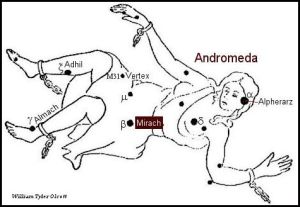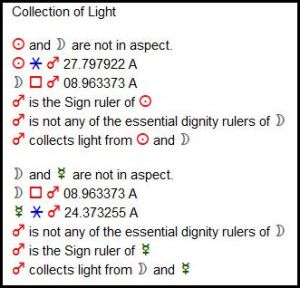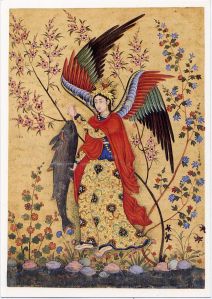
Credit BRITISH LIBRARY / SCIENCE PHOTO LIBRARY
Caption Persian astronomy. Historical artwork showing a group of astronomers led by Persian astronomer Nasir al-Din Tusi (Nasireddin or Tusi, 1201-1275) at his observatory near Meraga (Maragheh) in what is now northwestern Iran. The observatory was established in 1259. Several other prominent astronomers worked here with Tusi. Twelve years of observations produced the Ilkhanic Tables of planetary movements, completed in 1272. This artwork is a miniature painting from the manuscript ‘Tevarih-i guzide’ (circa 1563).
With respect to the great Persian astrologers of the pre and early Islamic period of the Sassanian dynasty (224-651 CE) one requires some working knowledge of the influential Bundahisn, meaning “Primal Creation,” also known as the Zoroastrian Book of Creation.
A series of cataclysmic invasions of Persia resulted in the destruction of the bulk of the Zoroastrian scriptures, namely the Avesta. The first assault was suffered during Alexander of Macedonia’s invasion in 330 BCE. This was accompanied by devastation and mass killings of priests who had preserved the work in an oral tradition. Then between 640-650 CE came the Arab Muslim invasions bent on mass conversions and the burning of Persian texts, including the Avesta. What fragments remained were largely destroyed in the Mongol and Turkic invasions. The result is that “today, out of the twenty-one books of the Sassanian era Avesta, only one complete book and fragments of others survive. The surviving texts are nevertheless one and a half times the size of the Koran, and are arranged as five books plus fragments.” (See K. E. Eduljee).
This reality makes the recovery of the Greater Bundahishn that much more important. This brief article is meant as a concise introduction to the work and its enormous significance.
The Persian contribution to early astronomy and astrology should not be underestimated, At the time of Persian history, particularly from the last decades of the fifth century BC until Alexander’s conquest was the most fertile period of Babylonian mathematical astronomy.:
“Astronomical schools existed in Uruk, Sippar, Babylon and Borsippa. The Achaemenians maintained an atmosphere favourable to the development of science. Under Darius, a great Babylonian astronomer, Nabu-rimanni (Naburianus), was instructed to carry out a study of lunar eclipses and arrived at calculations more accurate than those of Ptolemy and Copernicus. His works were translated and used for many centuries by all including Seleucid and Parthian rulers of Persia. His picture of Heavens was borrowed by the Greeks and eventually reached the famous Greek scientist Democritus. The terminology employed by Naburianu includes spheres, orbits, ecliptic, inclination, celestial equator, poles, circular motion, revolutions, retrogression, moon’s highest north and south latitudes. All were used extensively by Greek astronomers including the brilliant Eudoxus of Cnidus, precursor of Euclid. Another well known Babylonian astronomer under Persian rule, Kidinnu (Cidenas) of Sippar, distinguished the solar year from the lunar, discovered the precession of the equinoxes and arrived at an exact calculation of the length of the year, making an error of only 7 minutes, 41 seconds.” See Astrology & Astronomy in Iran and Ancient Mesopotamia by Massoume Price.
As I have indicated elsewhere:, The Greater Bundahishn is a compendium of ideas that are believed to pre-date Zoroastrianism, but the core is true to the cosmology of that religion. There are also some elements that would indicate knowledge relatively contemporary to its ninth-century appearance.
Fortunately, a brilliant new critical edition and translation of this work was completed by Domenico Agostini & Samuel Thrope and published by OUP in 2020 All references to the Bundahisn in the current article to this edition, unless otherwise stated.
I will focus specifically on the Creation of the Lights as described in The Greater Iranian Bundahishn. I would contend that without an understanding of this, the astrological writers of the period can be but partially understood. It will become apparent that although the text is first and foremost a Zoroastrian and Persian text, it reveals the extent to which Hellenistic and Indian traditions were well understood by the Persian author(s).
It behoves us to familiarize ourselves with the philosophical, cosmological or mystical underpinnings of any given system. This is an essential step in understanding the context of extant writings in Persian astrology, of which there is an abundance, most of which has only recently been translated into English.
It is also important to understand that: “Astronomy and its companion ‘applied science’ of astrology, were central features of the intellectual landscape of the early Islamic period . Observations of the heavens as well as the science of astronomy, have long pedigrees in Iranian culture generally and in Zoroastrian texts specifically. During the Sassanian period, Babylonian, Greek, and Indian traditions were synthesized in a single science that was part of the inherited Islamic intellectual tradition. “A special class of professionals were active in the art at the Sasanian court, producing horoscopes and predictions, as well as serving as translators and specialists on mathematical and scientific issues.” (Bundahisn p.16).
In a commentary to his own translation, Zeke J.V. Kassock states that “The Bundahishn is a collection of ideas, cosmogonies, cosmologies, histories, genus species and geographies. Most information is from pre-Sassanian Iran and Sassanian Iran, though some are from post-Islamic Iran. It can be divided into two categories, the Greater (Iranian) Bundahishn, and the Lesser (Indian) Bundahishn.” (The Greater Iranian Bundahishn A Pahlavi Student’s 2013 Guide p.i )
This Greater Bundahishn is approximately twice as long. as the Lesser (Indian ) Bundahishn. Neither is considered scripture. The Greater, in particular, draws heavily from the Avesta and Zoroastrianism, often starting sentences with “Gōwēd pad Dēn
kū”, “It is said in the Religion.” (ibid.) 
The Bundahishn, or Zoroastrian ‘Primal Creation’ 17th or 18th Century – British Library Mss Avestan 22The text of the Bundahišn “probably grew through different redactions, but it is not possible to provide a precise date the first compilation was made. . Most scholars subscribe to the view … that it is “an original work on cosmology in which the scattered teachings of the Avesta were coordinated and brought into a system by an author who, living presumably towards the end of the Sassanian epoch, possessed an encyclopaedic knowledge of the Avestic literature … This author also had some knowledge of the Greek scientific literature that had reached Iran under the Sassanians. For example, the contents of chapter XXVIII bear a similarity to the Hippocratic treatise Peri hebdomádōn. Chapter II on astronomy manifests, besides nearly prehistoric views, an acquaintance with Greek and Indian science..” See the article in Encyclopedia Iranica for a more complete treatment of this.
The recent Oxford edition is splendid, distinguishing itself not only in its linguistic brilliance but also with respect to its insightful and extensive commentary. It is however expensive and is not likely to be available to most of my readers. I, therefore, quote from Zand-Akashi: Iranian or Greater Bundahishn. Trans. Behramgore Tehmurus Anklesaria Published for the Rahnumae Mazdayasnan Sabha by its Honorary Secretary Dastur Framroze A. Bode. Bombay 1965.
What follows is the complete text of the second chapter of The Bundahishn. using that edition. The entire chapter is less than three printed pages in length, but contains the essence of Persian astronomical sensibility.
CHAPTER II: As regards the procreation of the Luminaries.

Illustration of the zodiac in the Bundahišn, ed. and tr. M. Bahar, 1990, p. 58.
1. Ohrmaz created [forth] the Luminaries, between the Sky and the Earth; the stars of the constellations and also those which were not of the constellations [were stationed], then the Moon, and then the Sun.
2. As, He first created the firmament; the stars of the constellations were fixed thereon, especially these twelve, whose names are: the Ram, the Cow, the Twins, the Crab, the Lion, the Husk of Corn, the Balance, the Scorpion, the Centaur, the Goat, the Pot, and the Fishes, which are subdivided into twenty-eight asterisms of reckoning, the names of which [are these]: Padevar, Pesh-parviz, Parviz, Paha, Aze-sar, Beshn, Rakhvat, Taraha, Azara, Nahn, Maian, Avdem, Mashaha, Spor, Husru, Sroi, Nur, Gelu, Grafsha, Varant, Gao, Goi, Muru, Bunda, Kaht-sar, Vaht, Mayan, Kaht; all the original material creations made their residence thereon, so that when the Adversary, would arrive, they might fight against their own enemy and the creatures might be saved from their antagonist; each of these constellations is a specimen of a soldier and veteran, who is
posted for battle; six thousand four hundred eighty (thousand) small stars are created forth, for help, [those which the astronomers now number, besides those innumerable, as, they are for their mutual-help.]
3. Over these constellations, He appointed four chieftains, in four directions; He appointed a chieftain over these chieftains; He appointed many innumerable stars that are [33] recognised by name, in various directions and various places, as givers of vigour, by cooperation, to these Constellations.

Constellations of Ursa Major, detail, from Persian Manuscript 373. Zodiac. MS PERSIAN (373). Work ID: mcauucez.
4. As one says: “Sirius [Tishtar] is the chieftain of the East, Sataves the chieftain of the South, Antares [Vanand] the chieftain of the West, the Seven Bears [Haptoring] the chieftain of the North; the Lord of the throne, Capicornus, whom they call the Lord of Mid- Heaven, [is the chieftain of chieftains; Parand, Mazd-tat, and others of this list are also chiefs of the directions
5. And astronomers call these stars of the directions and sides as leaders; and they mention the first magnitude, the third magnitude, …… as to the big, small, and middling stars.
6. He ordained this firmament in the semblance of a year: the twelve constellations like twelve months every constellation having thirty degrees, just as every month has thirty days.
7. He appointed the Seven Bears [Haptoring] in the Northern direction, thither where Dozakh [=hell -JHP] was, when the Adversary came in; a band from every region, out of the seven regions, is attached to it, for the organisation of the regions, in the mingled state: for that reason, it is called the’ Seven Thrones.’
8. He ordained the sphere, nature and class of these constellations so that they might remain in motion, in the mingled state.
9. Again, He arrayed, above them, the unmixable stars, so that, when the Adversary would arrive, they might repel him in the combat, and would not let him mingle with the higher sphere; He appointed the Glory of the good Mazdayasnian Religion, as chieftain

The horoscope of the world, after D. N. MacKenzie, “Zoroastrian Astrology in the ‘Bundahišn’,” BSOAS 273, 1964, p. 514.
over them; the place is called the brunt of the battle, the manifestation of purity in the mingled state; for this reason, they are called unmixable stars, because, when the Adversary came, they did not mingle with him; astronomers name a firmament which is above the firmament, where through there is no ebb and descent, for they cannot judge the mixable stars and the substance of the pure-bodies.
10. Above that, He created the Moon having the seed of the Beneficent Animal.
11. Above that, He created the shining swift-horsed Sun.
12. He appointed the Moon and [35] the Sun, as chieftains of those mixable stars; that is, they are all bound to the Sun and the Moon.
13. Above the Sun. He created the Throne of the Beneficent Immortals, which is attached to the Endless Light, the Throne of Ohrmazd.
14. These, too, are the six stations of the six creations, just as the creations of material life are six.
15. And in the midst of the half of the firmament, He appointed the Wind, the Cloud and the Fire Vazisht, so that, when the Adversary would arrive, they might seize the water of Sirius and produce rain; with the Spirit of the Water; He formed their connection, too, also with the Sun; the Moon, and the Stars; His valiant Sirius, who is the Chieftain of the East, is co-worker and associate of the Fire Vazisht, the Wind and the Cloud.
16. Of these stars, the big ones are as large as an eagle which is of the magnitude of a house, the middling are as large as a four-sided granary, and the small ones are as large as the head of a domestic ox; the Moon is as large as a race-course of two hathras; as, each hathra on earth is like an average frasang; the Sun is as large as Eranvej.
17. Until the coming of the Adversary, the Moon, the Sun and the stars were standing still, they did not move, and were passing their time with purity, and it was always mid-day; after the coming of the Adversary, they were in motion and would not desist from that motion, until the end.
18. The motion of the Sun is like that of a very large three-feathered arrow, when a very big man darts it from a very large bow; the motion of the Moon is just like that of an average three-feathered arrow, when an average man darts it, from an average bow; the motion of the stars is like that of a small three-feathered arrow, when a short man darts it from a small bow.
19. Of these constellations; Tishtar [Orion], Besn, Taraha, Azara, Pateywar, and Pesh-parviz are of very swift motion.

Sirius (bottom) and the constellation Orion (right). The three brightest stars in this image—Sirius, Betelgeuse (top right) and Procyon (top left)—form the Winter Triangle. The bright star at top center is Alhena, which forms a cross-shaped asterism with the Winter Triangle.
20. The mean duration of the Sun, from the time when it leaves a constellation until it attains to the next, is as much as is requisite for a man who takes up a stone and throws it.
This brief introduction to the core of the Zoroastrian myth as it relates specifically to the operation of the planets, luminaries and fixed stars provides valuable context in relation to the study of Persian astronomy and astrology. In a subsequent article, we may address the nature of the constellations in greater detail.
 constellation originally associated with this mansion is Andromeda.The principal star associated with this mansion is Mirach (beta Andromeda).The key theme here is one of endings. Dorotheus suggest that even a partnership beginning well, will end badly.
constellation originally associated with this mansion is Andromeda.The principal star associated with this mansion is Mirach (beta Andromeda).The key theme here is one of endings. Dorotheus suggest that even a partnership beginning well, will end badly.



































